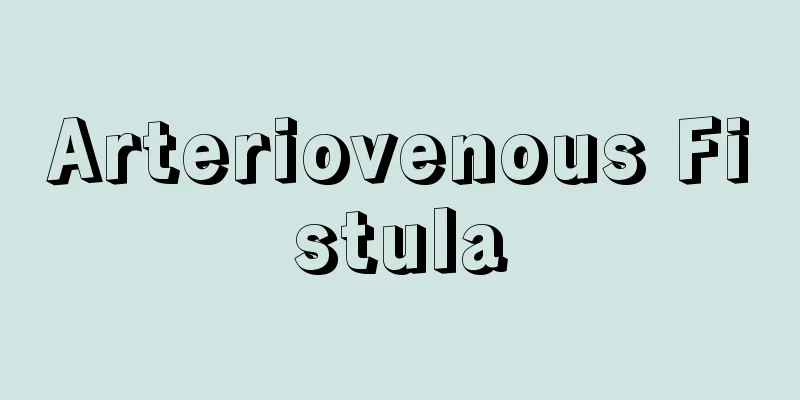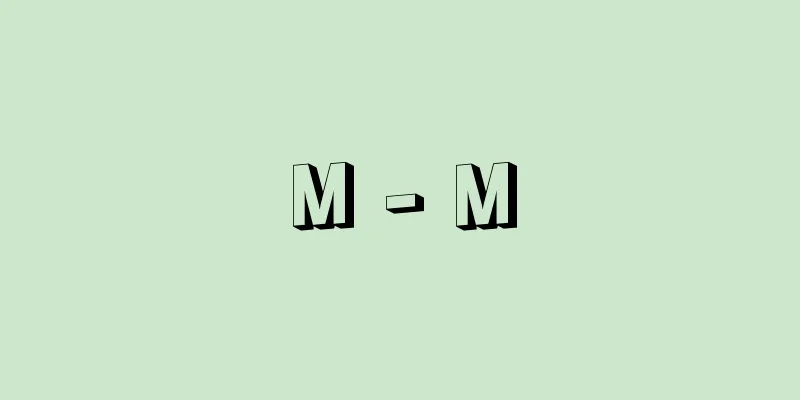Arteriovenous Fistula

|
[What kind of disease is it?] Blood that flows through arteries passes through capillaries before flowing into veins. However, sometimes an abnormal short circuit occurs, and the arteries and veins connect directly without passing through the capillaries. This is called an arteriovenous fistula. [Cause] They can be present at birth (congenital) or acquired (traumatic). ■ Congenital arteriovenous fistula There is an abnormality in the formation of blood vessels in the womb, and as the baby grows, fistulas (a tissue defect) gradually form. Hemangiomas also often form fistulas, although to varying degrees. They are said to easily form not just in one place, but in various parts of the body, especially in the hands and feet, spinal cord, brain, and lungs ("arteriovenous fistulas"). ■ Acquired (traumatic) arteriovenous fistula The most common cause is trauma, such as a stab wound or gunshot wound, and it can also occur after a catheter examination. [Symptoms] Small shunts are asymptomatic or only have localized symptoms. However, as the amount of shunt increases, the diameter of the veins increases, causing varicose veins and swelling. In addition, the blood flow increases, putting more strain on the heart, which can cause the left ventricle to enlarge and lead to heart failure. On the other hand, the amount of blood decreases on the peripheral (farther from the heart) side of the shunt, resulting in circulatory disorders such as coldness, pain, and cyanosis. [Testing and diagnosis] Angiograms and ultrasound scans may be performed to confirm the diagnosis and determine treatment options. [Treatment] If the fistula is large, a surgical procedure will be performed to tie off the shunted artery and vein and remove the affected area. If the fistula is small, a thin tube called a catheter is inserted into the blood vessel to block the shunting blood vessel. In cases of congenital abnormalities, where the abnormal blood vessels reach muscles or bones, or over a wide area, surgical or catheter treatment becomes difficult. In such cases, elastic stockings are used to suppress swelling, and care should be taken not to strain the body or injure oneself. Arteriovenous FistulaArteriovenous fistulas ("arteriovenous fistulas") are found in the systemic circulatory system (systemic arteriovenous fistula), the pulmonary circulatory system (pulmonary arteriovenous fistula), and the coronary circulatory system, which is the vascular system that nourishes the heart (coronary arteriovenous fistula or simply coronary artery fistula). In the case of pulmonary arteriovenous fistula, gas exchange does not take place because the blood does not pass through capillaries, and venous blood with low oxygen content returns directly to the pulmonary veins, which may result in cyanosis. In the case of a coronary artery fistula, gas exchange and nutrient transmission in the myocardium are impaired, which may lead to myocardial ischemia (a condition in which blood does not circulate sufficiently to the myocardium). In the case of a systemic arteriovenous fistula, the volume of systemic circulating blood (cardiac output) increases to compensate for the shunting blood. It is known that even under normal conditions, some blood flows from small arteries to small veins without passing through capillaries, but this is a very small proportion of blood and does not pose any particular problems in everyday life. [Treatment] Treatment for pulmonary arteriovenous fistula is performed by catheter treatment or surgery if necessary, depending on the degree of cyanosis and the amount of shunt. Sometimes, treatment can be difficult. Coronary artery fistulas are treated by catheter therapy or surgery depending on the amount of shunt and whether or not myocardial ischemia is present. In the case of systemic arteriovenous fistula, the shunt volume, i.e., an increase in cardiac output, or local symptoms in the area or organ where the arteriovenous fistula is located, are the key points to determine whether treatment is necessary. Catheterization and surgery are used for treatment. There are also cases where treatment is difficult. Source: Shogakukan Home Medical Library Information |
|
[どんな病気か] 動脈を流れてきた血液は、毛細(血)管を経由してから静脈へと流れていきます。ところが、異常な短絡(たんらく)交通路ができ、毛細管を経(へ)ないで動脈と静脈が直接つながってしまうことがあります。これを動静脈瘻といいます。 [原因] 生まれつき(先天性)のものと、後天性(外傷性)のものとがあります。 ■先天性動静脈瘻(せんてんせいどうじょうみゃくろう) 胎内(たいない)での血管の形成に異常があり、成長とともに、しだいに瘻(ろう)(組織が欠損した状態)ができるものです。血管腫(けっかんしゅ)も、程度の差はあれ、瘻を形成していることが多いのです。1か所だけではなく、いろいろな部位、とくに手足、脊髄(せきずい)、脳、肺などにできやすいといわれています(「動静脈瘻」)。 ■後天性(こうてんせい)(外傷性(がいしょうせい))動静脈瘻(どうじょうみゃくろう) 刃物などによる刺創(しそう)や銃創(じゅうそう)など、外傷によるものがもっとも多く、カテーテル検査後に生じることもあります。 [症状] 小さな短絡では、無症状あるいは局所症状のみです。しかし、短絡量が多くなると静脈径が大きくなり、静脈瘤(じょうみゃくりゅう)や腫(は)れを生じます。また血流量が増加するので心臓の負担が多くなり、左心室(さしんしつ)が肥大して心不全(しんふぜん)をおこすこともあります。 一方、短絡部より末梢(まっしょう)(心臓より遠い)側では血液量が減少するため、循環障害による冷感、痛み、チアノーゼなどが現われます。 [検査と診断] 診断を確定させるため、あるいは治療法を決めるために、血管造影や超音波検査などが行なわれます。 [治療] 瘻孔(ろうこう)が大きい場合は、外科的に、短絡している動静脈を縛り、病変部を切除する手術が行なわれます。 瘻孔が小さい場合は、カテーテルという細い管を血管内に挿入して短絡血管を閉塞(へいそく)させる方法が行なわれます。 先天性のもので、異常血管が筋肉や骨におよんだり、広範囲におよぶ場合は、外科治療やカテーテル治療がむずかしくなります。その際には、弾力ストッキングを使って腫れを抑え、むりをせずけがしないように心がけます。 どうじょうみゃくろう【動静脈瘻 Arteriovenous Fistula】動静脈瘻(「動静脈瘻」)は、体循環系(たいじゅんかんけい)(体動静脈瘻)、肺循環系(はいじゅんかんけい)(肺動静脈瘻)、心臓を養う血管系である冠循環系(かんじゅんかんけい)(冠動静脈瘻あるいは単に冠動脈瘻)にみられます。 肺動静脈瘻の場合は、毛細血管を経ないため、ガス交換が行なわれず、酸素の含量の少ない静脈血がそのまま肺静脈にかえってくるため、チアノーゼがみられることがあります。 冠動脈瘻の場合は、心筋でのガス交換や栄養の伝達が悪くなり、心筋虚血(しんきんきょけつ)(心筋に十分血液がまわらない状態)をおこすことがあります。 体動静脈瘻の場合は、短絡(たんらく)する血液を補うため、体循環血液量(心拍出量(しんはくしゅつりょう))が増加した状態になります。 正常の状態でも、毛細血管を経ずに小動脈から小静脈に流れる血液があることが知られていますが、これはごく一部であり、日常生活においてはとくに問題となりません。 [治療] 肺動静脈瘻の治療は、チアノーゼの程度、短絡量の大小により、必要があればカテーテル治療や手術が行なわれます。ときに、治療が困難な場合もあります。 冠動脈瘻の治療には、短絡量の大小、心筋虚血の有無により、カテーテル治療や手術が行なわれます。 体動静脈瘻の場合は、短絡量すなわち心拍出量の増大、あるいは動静脈瘻のある部位や臓器の局所症状が、治療を必要とするかどうかを判断するポイントになります。治療には、カテーテル治療や手術が行なわれています。また、治療が困難な場合もみられます。 出典 小学館家庭医学館について 情報 |
Recommend
Millikan - Robert Andrews Millikan
American experimental physicist. Known for Millik...
Lepus timidus ainu (English spelling) Lepustimidusainu
…[Yoshiharu Imaizumi]. … *Some of the terminology...
Burgess fauna
A unique fossil fauna found in the Burgess Shale ...
Mothers' Conference - Hahaoya Taikai
The purpose of this conference is to discuss vario...
garland flower
…A perennial herb of the ginger family with fragr...
differential centrifugation
…Generally, cells are disrupted in a non-electrol...
Dingcun ruins
A group of Middle Paleolithic ruins near Dingcun,...
Bishop Museum - Bishop Museum
The Bernice Pauahi Bishop Museum, officially named...
Pan-African Conference
… In the first half of the period, that is, befor...
Jan Joosten van Lodenstijn
?-1623 A Dutch trader. In 1600 (Keicho 5), he was ...
Kankiyakata Beninagashi - Kankiyakata Beninagashi
…In the case of modern theatre, Kaoru Oyamauchi a...
Amagatsuki - Amagatsuki
...Also written as ama-ji. A human-shaped doll us...
Scientism - kagakushugi (English spelling) scientism
A term given to a part of the philosophy of empiri...
National Army (English: Garde nationale) (French)
A militia organization formed during the French R...
Cercartetus concinnus
...Marsupial [Yoshiharu Imaizumi]. . … *Some of t...









